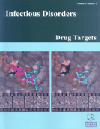- Home
- A-Z Publications
- Infectious Disorders - Drug Targets (Formerly Current Drug Targets - Infectious Disorders)
- Previous Issues
- Volume 10, Issue 3, 2010
Infectious Disorders - Drug Targets (Formerly Current Drug Targets - Infectious Disorders) - Volume 10, Issue 3, 2010
Volume 10, Issue 3, 2010
-
-
Editorial [Hot topic:Promising Drug Targets in the Identification of Novel Antimalarials (Guest Editor: Norman C. Waters)]
More LessMalaria is a devastating disease that kills approximately two million people annually. The causative agent of malaria is a protozoan parasite from the genus Plasmodium. Of the species that infect man, Plasmodium falciparum is responsible for the majority of mortalities. Many efforts have been initiated to eliminate or reduce the malaria burden however in the absence of an effective vaccine; drugs must be used for prophy Read More
-
-
-
Exploring Novel Targets for Antimalarial Drug Discovery: Plasmodial Protein Kinases
More LessAuthors: Dayadevi Jirage, Susan M. Keenan and Norman C. WatersProtein kinases are pursued drug targets in numerous diseases including parasitic infections such as malaria. Plasmodium falciparum, the deadliest malarial parasite, relies on numerous protein kinases to regulate growth and differentiation through a complex life cycle that alternates between an invertebrate and vertebrate host. Many of the protein kinases are uncharacterized, however genetic and biochemical approaches have i Read More
-
-
-
Malaria Heat Shock Proteins: Drug Targets that Chaperone other Drug Targets
More LessAuthors: E.-R. Pesce, I.L. Cockburn, J.L. Goble, L.L. Stephens and G.L. BlatchOngoing research into the chaperone systems of malaria parasites, and particularly of Plasmodium falciparum, suggests that heat shock proteins (Hsps) could potentially be an excellent class of drug targets. The P. falciparum genome encodes a vast range and large number of chaperones, including 43 Hsp40, six Hsp70, and three Hsp90 proteins (PfHsp40s, PfHsp70s and PfHsp90s), which are involved in a number of fundam Read More
-
-
-
Targeting the Plasmodium Ubiquitin/Proteasome System with Anti- Malarial Compounds: Promises for the Future
More LessAuthors: Duk-Won Doug Chung and Karine G. Le RochThe human malarial parasite, Plasmodium falciparum, is responsible for one of the most infectious diseases of the world and is quickly gaining resistance to the commonly used antimalarial treatments. New data are continually reinforcing the idea that biological functions associated with the ubiquitin proteasome system (UPS) are not just limited to non-lysomal degradation of proteins but consist of a wide array of regulato Read More
-
-
-
Leveraging Cell Cycle Analysis in Anticancer Drug Discovery to Identify Novel Plasmodial Drug Targets
More LessAuthors: Sergei Kozlov, Norman C. Waters and Marina ChavchichCancer and malaria are life threatening diseases killing millions of people each year. In spite of our best efforts, both continue to resist full control and eradication. If untreated, both malaria and cancer can lead to death. Only a few antimalarial drugs have been developed over the last decades and new drugs are urgently needed to combat drug-resistant parasites. Significant progress has been made in understanding the molec Read More
-
-
-
Targeting Plasmodium Falciparum Purine Salvage Enzymes: A Look At Structure-Based Drug Development
More LessAuthors: T. Donaldson and K. KimNew antimalarials are needed due to the rapid development of resistance to currently deployed drugs. Because Plasmodium species are unable to synthesize purines, purine salvage pathways have been proposed as novel anti-malarial targets. The purine salvage pathway in Plasmodium is streamlined with adenosine deaminase (ADA), purine nucleoside phosphorylase (PNP) and hypoxanthine-xanthine-guanine-phosphoribos Read More
-
-
-
Pantothenate Utilization by Plasmodium as a Target for Antimalarial Chemotherapy
More LessAuthors: C. Spry, D.A. van Schalkwyk, E. Strauss and K.J. SalibaIn the absence of an effective vaccine against malaria suitable for widespread deployment, the control of this lethal infectious disease relies heavily on antimalarial chemotherapies. The most virulent of the parasites that cause malaria (Plasmodium falciparum) has, however, developed resistance to all antimalarial agents in clinical use, and there is a desperate need for new antimalarial agents that target previously unex Read More
-
-
-
Aminopeptidases of Malaria Parasites: New Targets for Chemotherapy
More LessNovel targets for new drug development are urgently required to combat malaria, a disease that puts half of the world's population at risk. One group of enzymes identified within the genome of the most lethal of the causative agents of malaria, Plasmodium falciparum, that may have the potential to become new targets for antimalarial drug development are the aminopeptidases. These enzymes catalyse the cleavage of t Read More
-
-
-
Plasmodium Dihydroorotate Dehydrogenase: A Promising Target for Novel Anti-Malarial Chemotherapy
More LessAuthors: Margaret A. Phillips and Pradipsinh K. RathodMalaria remains a globally prevalent infectious disease that leads to significant morbidity and mortality. While there are a number of drugs approved for its treatment, drug resistance has compromised most of them, making the development of new drugs for the treatment and prevention of malaria essential. The completion of the Plasmodium falciparum genome and a growing understanding of parasite biology Read More
-
Volumes & issues
-
Volume 25 (2025)
-
Volume 24 (2024)
-
Volume 23 (2023)
-
Volume 22 (2022)
-
Volume 21 (2021)
-
Volume 20 (2020)
-
Volume 19 (2019)
-
Volume 18 (2018)
-
Volume 17 (2017)
-
Volume 16 (2016)
-
Volume 15 (2015)
-
Volume 14 (2014)
-
Volume 13 (2013)
-
Volume 12 (2012)
-
Volume 11 (2011)
-
Volume 10 (2010)
-
Volume 9 (2009)
-
Volume 8 (2008)
-
Volume 7 (2007)
-
Volume 6 (2006)
Most Read This Month
Article
content/journals/iddt
Journal
10
5
false
en


